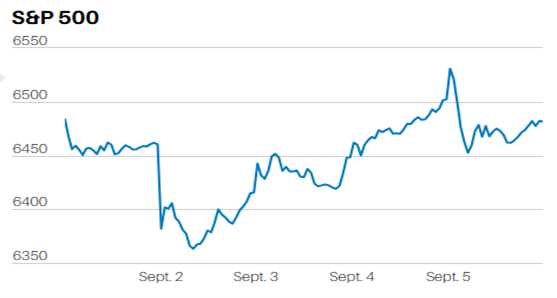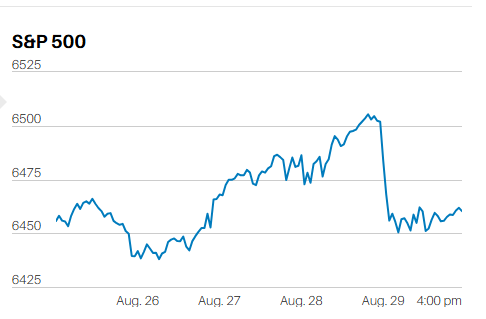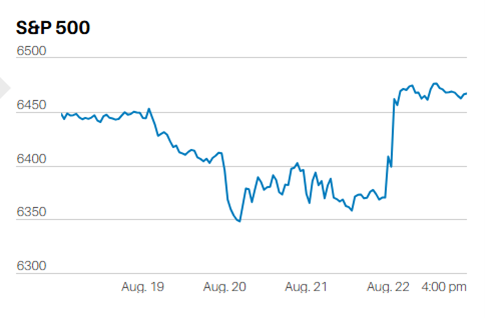Earnings estimates are too high, stocks likely to struggle

Market Update
The S&P 500 lost 2.1% last week. It closed Friday at 4,369.71. The index has fallen 5.2% since reaching a 52-week high July 27th. We wrote about the likelihood of a pullback in Vol. 238. “The risk is high of a short-term pullback. The 50-day moving average is at 4,370 and is a reasonable target. It would be a 5% pullback.” The 100-day moving average is next support at 4,300. Rising long-term interest rates are pressuring stocks. We wrote last week that, “Rising rates may have caused traders to sell stocks. A continued rise in long-term rates would pressure the stock market.” The Nasdaq was down 2.6% last week. Expensive growth stocks will struggle if long-term rates continue to move higher.
The 10-year U.S. Treasury note hit 4.30% on Thursday, up from 3.97% on 31 July. The 10-year yield has risen rapidly from 3.30% on 30 April. It is at its highest level since 2007. The 30-year U.S. Treasury note rose to 4.41% on Thursday. The 30-year is at its highest level since 2011. The yield on 10-year Treasury inflation-protected bonds was negative until May of last year. It touched 2% on Friday, its highest level since 2009.
“Equity markets will remain under pressure while the 10yr is increasing,” writes Dennis DeBusshere, chief market strategist at 22V Research. The 10yr is likely to continue increasing given the strength in the economy. Retail sales, housing starts, and industrial production were all above expectations last week. The Atlanta Fed’s GDPNow tool projects 5.8% growth for the third quarter.
Strong economic data, including low unemployment, argues for tighter monetary policy. The Federal Open Market Committee seems to agree. Minutes were released for the July 25-26 meeting last week. “With inflation still well above the Committee’s longer-run goal and the labor market remaining tight, most participants continue to see significant upside risks to inflation, which could require further tightening of monetary policy.”
J.P. Morgan put out a note on inflation last week. It sees core CPI proving to be sticky at a 3% annual rate. The tight labor market is a major factor likely to keep inflation well above 2% in the foreseeable future. Job growth has averaged around 217,000 for the three months ended in July. The growth rate is more than double the 100,000 jobs per month needed to keep up with population growth, according to Fed estimates.
Former Treasury Secretary Lawrence Summers was pounding the higher interest rate drum last week. He is predicting that the 10-year Treasury will continue to rise. He believes the benchmark will average 4.75% over the next decade. The 10-year has averaged 2.90% over the last 20 years. Summers made his comments during a Bloomberg interview.
The Fed meeting minutes, and Larry Summers comments suggest higher interest rates ahead. Joseph Carson, former chief economist at AllianceBernstein agrees. Interest rates haven’t risen enough to slow the economy, he says. The Federal Funds rate has been below the inflation rate until recently. Carson thinks another 1% in hikes is needed.
Yet the futures market continues to predict no further rate hikes from the Fed. The CME FedWatch tool is even indicating rate cuts as soon as May 2024. The Fed hasn't cut rates this century unless the economy was entering a recession. Jim Bianco of Bianco Research made that point to Barron’s in an interview last week.
High and rising long-term interest rates will continue to pressure the stock market for two reasons. Bonds become more attractive, pulling money away from stocks. Also, the cost of rising capital impacts corporate earnings. Doug Peta is chief U.S. strategist at BCA Research. He sees corporate earnings coming in well below forecasts. Norwood Economics has been writing all year that earnings estimates are too high. Estimates have been falling all year and are down to $219.43 for 2023. Earnings are forecast to grow by 11.9% in 2024 and 12.3% in 2025. Both estimates are too high. Peta sees 2024 earnings falling 5% to $210 in S&P 500 per share earnings. The S&P 500 P/E is 21x based on Peta’s 2024 estimate. The average is 15.5X.
The stock market is likely to struggle for the next few years. Earnings growth is unlikely to meet lofty expectations. Earnings growth will disappoint because inflation and interest rates will remain higher than during the last twenty years. There are several structural changes that argue for that scenario. The push to restore domestic supply chains is inflationary. An aging population is inflationary as well because it leads to tight labor markets. High debt is also likely to lead to higher inflation. The government needs inflation to make it easier to repay borrowings. And what the government wants the Fed can deliver. It goes without saying (but we’ll say it anyway) that we’ll have a bear market if a recession does materialize. Norwood Economics expects a recession in 2024. Risk management in an uncertain environment remains a priority.
Economic Indicators
The leading economic indicators (LEI) index fell for the 16th month in a row. It declined by 0.4% in July. Seven of the 10 indicators that compose the LEI fell. The current conditions indicator (CEI) rose 0.4% in July. The CEI is signaling that we are currently still in a favorable growth environment,” said Justyna Zbinsak-La Monica, a senior manager of business cycle indicators at the Conference Board. The Conference Board is still predicting a short, shallow recession. It thinks the recession will start by year-end. The Atlanta Fed GDPNow tool is predicting 5.8% growth in Q3. The economy must decelerate quickly for the Conference Board forecast to materialize.
A stronger-than-forecast retail sales number on Tuesday caused interest rates to rise. The stock market fell in response. The S&P gapped down at the open following the report. It fell from 4,490 to close Tuesday at 4,437.86. Rising long-term rates are creating stress in the stock market. The retail sales numbers only added to the pain. U.S. retail sales rose 0.7% in July, ahead of expectations. Retail sales were expected to climb by 0.4% after rising 0.3% in June. Retail sales minus autos rose 1.0%, better than the expected 0.4% and last month’s gain of 0.2%. It was the biggest rise in retail sales in six months. Retail sales represent about one-third of all consumer spending.
The LEI points to recession in the next six to 12 months. Consumer and government spending point to robust growth in the third quarter. Rising interest rates will impact consumer spending in the next few quarters. The question is how fast the economy will slow and will it fall into recession in the process. The next twelve months promise to be interesting if nothing else.
Concentrated Portfolios and Lumpy Returns
Norwood Economics manages a concentrated portfolio of stocks. We do so because we want to outperform the stock market on a risk-adjusted basis over the long run. Owning the entire stock market means performing in line with the stock market minus fees. No one should pay a money manager a fee to stealth index. Unfortunately, most financial advisors’ stealth index. Most clients receive the market performance (or worse) minus fees because of stealth indexing. Yet they pay active management fees to their advisor. Clients shouldn't pay active management fees unless the advisor is actively managing. Active management means attempting to generate alpha (excess risk-adjusted return).
A concentrated stock portfolio of 20-25 stocks can outperform the stock market. It can underperform as well if the stock picking is bad. It depends on whether the portfolio manager is good at identifying undervalued stocks. Unfortunately for the client, it can take years to separate the good money managers from the bad.
Concentrated portfolio returns will often diverge from stock market returns. The reason is that the portfolio doesn't represent the market. The portfolio might trail far behind the market at times. It doesn't necessarily mean the strategy is failing. Good active managers outperform in the long run. They often don't outperform during shorter time periods. Lumpy returns come with the territory. Warren Buffett has famously pointed out that investors prefer lower, but smooth returns over higher but lumpy returns. He is right of course.
Norwood Economics is currently overweight communication services. We own five communication services stocks and are about to buy a sixth. Four of them are telecom service companies. The fifth is an entertainment company. The sixth is also an entertainment company. Norwood only owns 26 stocks. We will own 27 with 6 in communication services shortly. That’s 22% of portfolio holdings committed to communication services.
Communication services companies were hammered last year. We’ve been buying them on the way down. They are paying high dividends while we wait for them to return to fair value. We are sitting on losses for the time being. The communication services stocks have been a major drag on our short-term returns.
Telephone companies are an essential service with high barriers to entry. The upgrade cycle to 5G is well underway and free cash flow should follow over the next few years. Communication service companies tend to gush cash flow. The cash flow can be used to pay dividends, pay back debt, and repurchase shares. Norwood thinks the risk-adjusted return will be well above the stock market return.
Our losses in these businesses are unlikely to be large if we are wrong about the 5G upgrade cycle. Patience is a prerequisite to successful value investing. Business cycles are measured in years not months. We’ll have to wait and see how it works out for our communication service stocks. Regardless, creating concentrated value portfolios has a long history of outperforming. We don’t believe that will ever change.
Regards,
Christopher R Norwood, CFA
Chief Market Strategist











